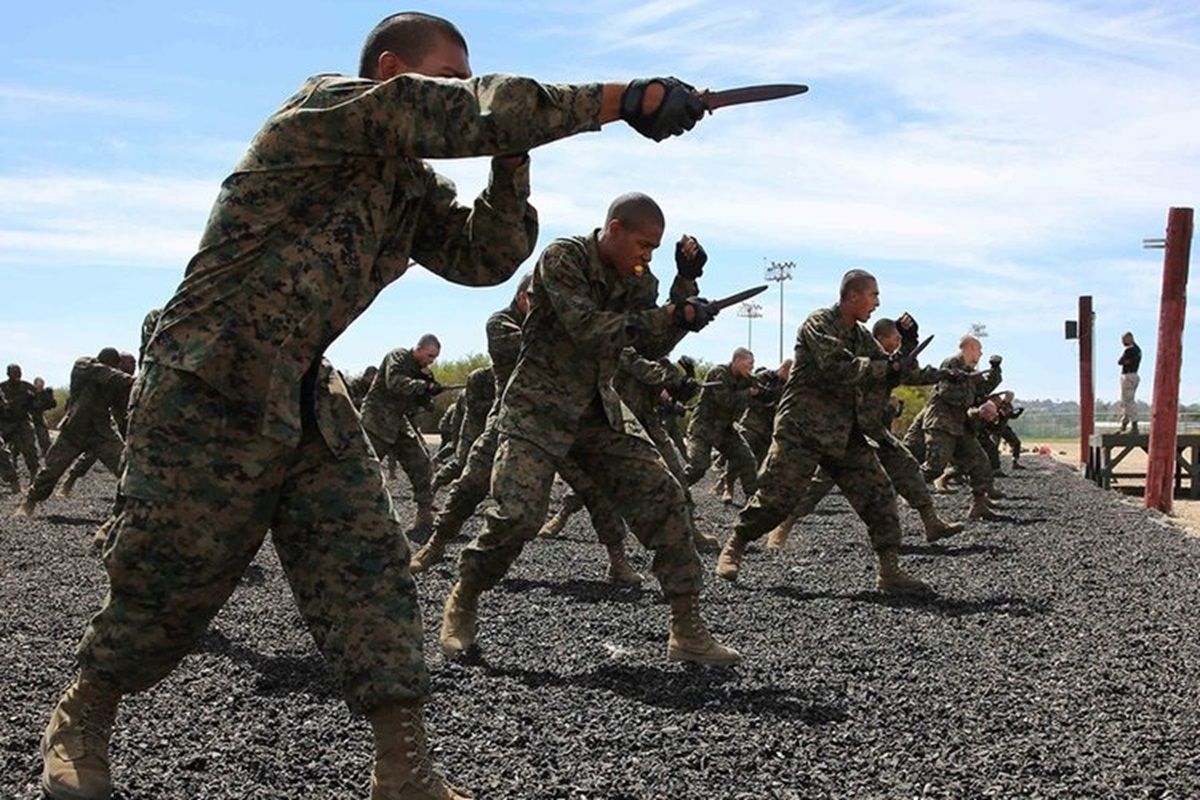
Knife Fighting Like a Marine
The Marine Corps extensively integrates knife combat into its training via the Marine Corps Martial Arts Program (MCMAP). Masters of the KA-BAR knife, there is no better organization to learn about knife fighting principles and techniques.
USMC knife fighting training encompasses fundamental techniques and practical applications, revealing the swiftness of such confrontations.
It’s vital to note that proper knife training should solely occur under expert supervision, emphasizing safety. This article plunges into the fundamental aspects of Marine Corps knife training.
Safety Considerations of Knife Fighting
Safety considerations are paramount in knife fighting training.
To minimize the risk of injury, students should use training knives, eye protection, and groin protection during all training sessions. Techniques should never be executed at full speed or with full body contact.
Training for knife techniques should be conducted in two stages. Initially, students should practice techniques “in the air” without contacting opponents or targets. This phase focuses on skill acquisition.
As students become more proficient, they can pair up. But both they and their opponents should remain stationary, with no physical contact permitted during this stage of training.
The Goal of a Knife Fight
The primary purpose of knife fighting in combat is to inflict severe damage and massive trauma on the opponent, effectively incapacitating them.
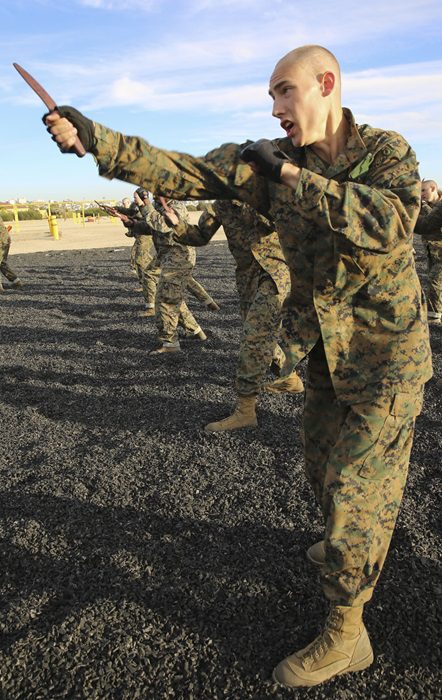
Angles of Attack
In a knife fight, understanding the angles of attack is vital for effective combat.
There are six primary angles from which an attack can be initiated. These include a vertical strike, descending straight onto the opponent, forward diagonal strikes at a 45-degree angle, and reverse diagonal strikes also at a 45-degree angle.
Additionally, forward horizontal strikes, parallel to the deck, and reverse horizontal strikes are employed.
Lastly, a forward thrust delivers a straight, linear attack directly toward the opponent. Mastery of these angles allows for versatile and strategic knife combat tactics.
Primary Targets in a Knife Fight
In a knife fight, targeting primary areas of the body is crucial for maximum impact. The objective is to strike soft body vital targets that are readily accessible, such as the face, sides, and front of the neck, as well as the lower abdomen or groin.
The neck, with its carotid arteries exposed and lacking protective coverage, is a prime target.
Similarly, the lower abdomen and groin region are vulnerable areas not typically protected by body armor.
Striking the aorta, if unprotected, can be rapidly fatal, causing incapacitation within seconds or minutes, making it a highly effective primary target.
Secondary Targets in Knife Fighting
Secondary targets in a knife fight can be crucial for causing significant bleeding due to severed arteries. While these targets might not be immediately fatal, they can become so if untreated.
Striking areas such as the legs can inflict substantial trauma. For instance, severing the femoral artery in the thigh can lead to severe blood loss.
Attacks on the brachial artery, situated inside the arm between the biceps and triceps, can also result in extensive bleeding and damage. Additionally, targeting the radial and ulnar nerves of the arm can lead to substantial bleeding and damage, making these secondary targets of strategic importance.
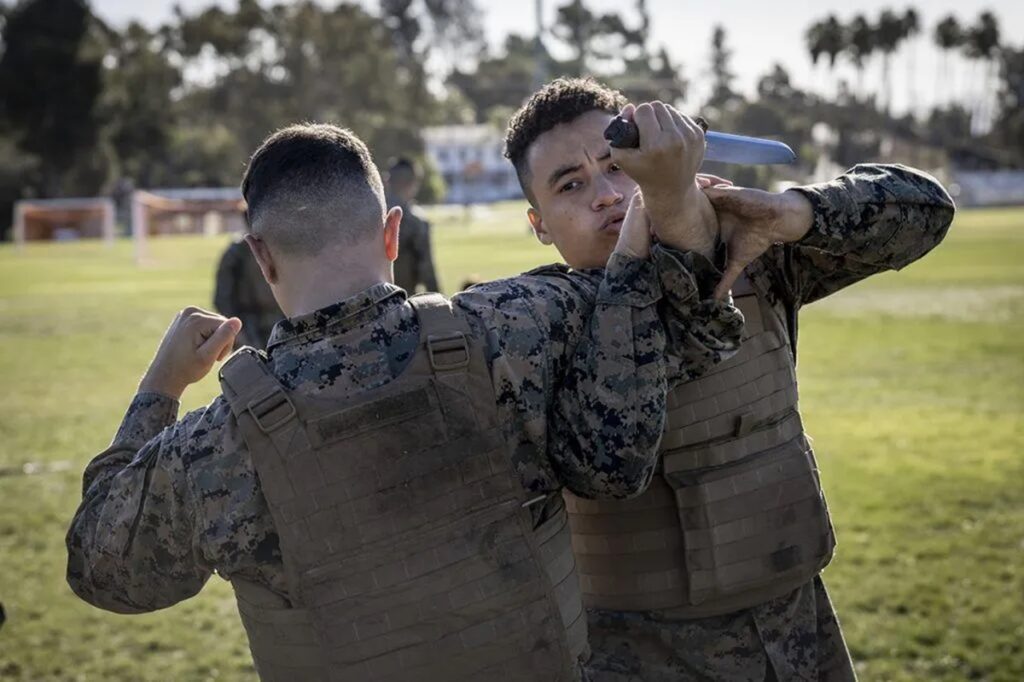
Movement in a Knife Fight
In a knife fight, understanding movement is crucial. Visualize a 360-degree circle around your opponent and strategically position yourself within this circle to gain advantages and target different areas of their body.
Being directly in front of an opponent is the least favorable position, as it allows them to use forward momentum and linear power.
Instead, moving at a 45-degree angle to either side of your opponent is optimal. This not only helps you avoid their strikes but also positions you for a more effective counterattack.
Wearing a Combat Knife
Marines wear combat knives, whether bayonets or fighting knives, for easy access and retention. It’s advisable to wear the knife on the weak-side hip, blade down, positioned behind the magazine pouch for accessibility while preventing it from being grabbed by an opponent.
Care should be taken to avoid wearing it next to a canteen, as this could lead to the knife becoming inaccessible due to the canteen sliding on the cartridge belt.
How to Grip a Combat Knife
In knife fighting, the grip is crucial. It should be natural, with your fingers wrapped around the knife’s grip as you pull it from its sheath. This grip is commonly referred to as a “hammer grip,” where the blade end always faces the opponent.
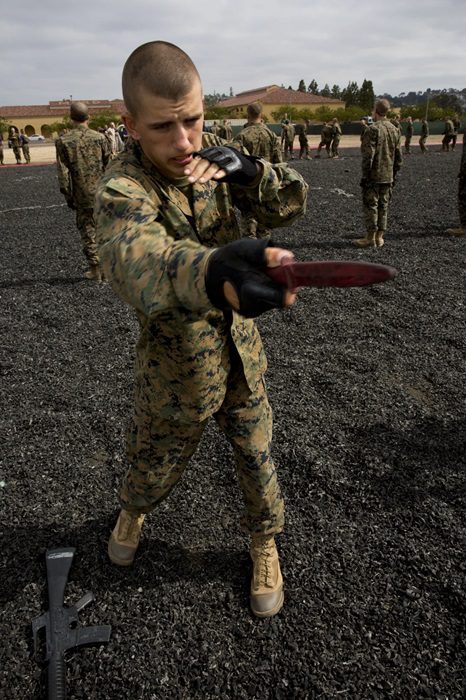
Knife Fighting Stance
In knife fighting, the stance is critical.
The basic warrior stance forms the basis for all knife techniques. The left hand acts as a vertical shield to protect the ribs or the head and neck. The right elbow should be bent, with the blade pointing forward towards the opponent’s head, serving as an index point for all techniques.
The weapon should be held at a level roughly from the top of the belt to chest high, kept close to the body to aid in weapon retention.
Principles of Knife Fighting
Several key principles should be followed for effective combat.
Firstly, when executing movements with the knife blade, it’s crucial to keep them within a defined box, running from shoulder-width across, starting from your neck down to your waistline. This approach ensures that your attacks remain precise. It also prevents the opponent from easily blocking your movements.
Secondly, maintaining the knife’s blade tip forward and pointed towards the opponent is essential. This positioning maximizes the readiness of your blade for any counteractions.
Lastly, for each knife technique, apply your full body weight and power. Your body’s weight should be directed into the attack, whether it’s a slash or thrust, in the direction of the blade’s movement. By doing so, you apply constant forward pressure with both your body and blade. This keeps the opponent off-balance and enhances the effectiveness of your attacks.
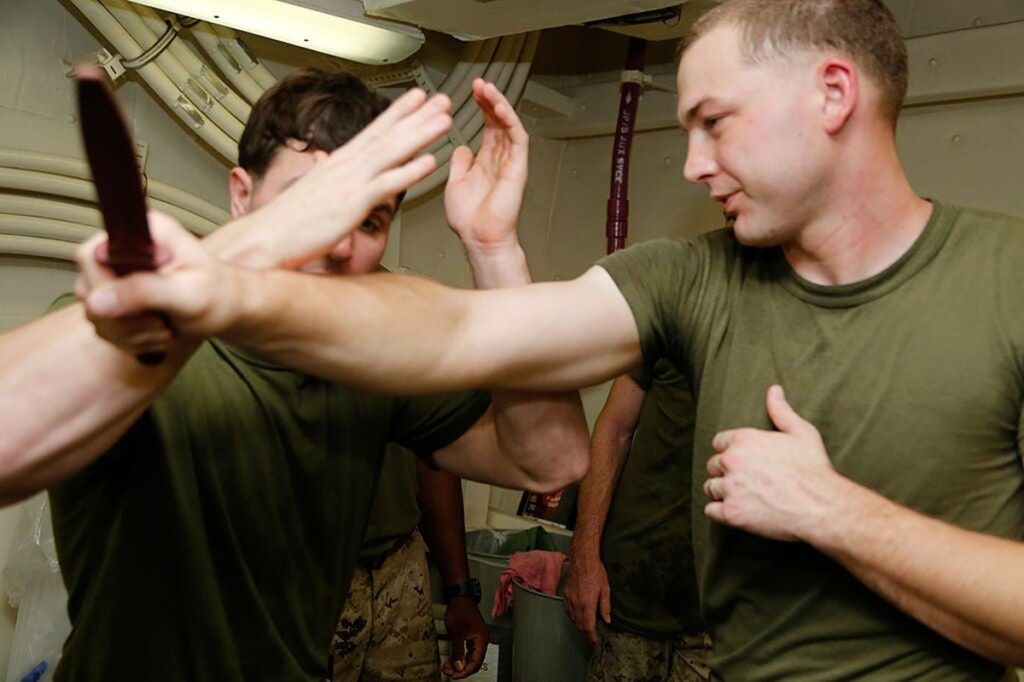
Intro To Knife Fighting Techniques
Vertical slashing techniques serve the purpose of closing the distance between the wielder and the opponent. These techniques are employed to distract the adversary or cause sufficient damage to enable a closer approach. Typically, the targets for vertical slashes are limbs or any vulnerable part of the opponent’s body.
The technique involves standing face-to-face with the opponent, extending the right hand, and bringing the weapon down in a straight motion along the opponent’s body. The knife maintains contact with the opponent’s body throughout the slashing motion, following a vertical line down the target area. After the slash, the modified basic warrior stance is resumed.
Vertical thrusting techniques, on the other hand, are considered more effective than slashing techniques due to their potential to cause severe damage. However, slashing techniques are used initially to close the distance with the enemy, allowing for thrusting techniques. The thrusting motion follows a vertical line either upward into the abdomen region or high into the neck.
To execute a vertical thrust, one stands facing the aggressor in the modified basic warrior stance, thrusts the right hand towards the target, inserts the knife blade straight into the aggressor, withdraws the knife, and then resumes the modified basic warrior stance.

Bayonet vs Fighting Knife
When considering the use of both the bayonet and fighting knife, it’s essential to understand their distinctions. The fighting knife is a sharp, single-bladed tool primarily designed for cutting and tearing.
In contrast, the bayonet is a dual-bladed knife with one edge being narrower and duller. The bayonet’s design makes it more effective for thrusting motions rather than slashing actions.
These considerations are crucial in determining the appropriate tool for specific combat situations and tactics.

Marine Corps Knife Training
Hopefully this article gave you a good overview of the principles and techniques of knife fighting. Check out our selection of training knives, KA-BAR combat knives, and bayonets to continue your self-defense and combat training.

